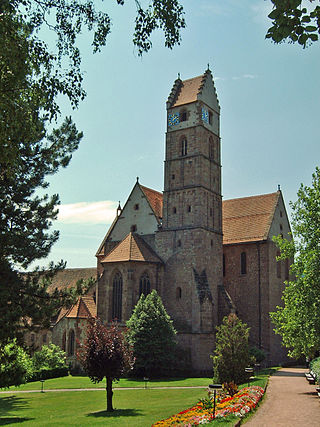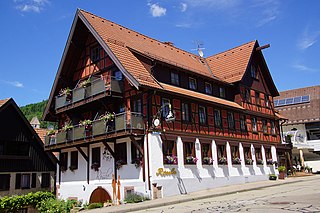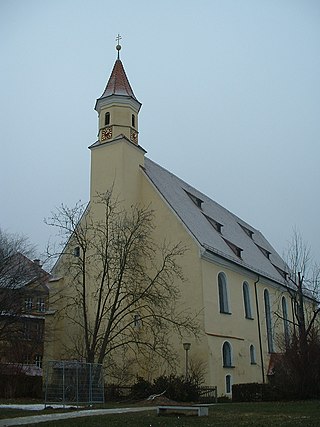
Wittichen Abbey (German : Kloster Wittichen) is a former Poor Clares abbey in Wittichen in a narrow side valley of the Kleine Kinzig stream near Schenkenzell in the upper Kinzig valley in the Black Forest.

Wittichen Abbey (German : Kloster Wittichen) is a former Poor Clares abbey in Wittichen in a narrow side valley of the Kleine Kinzig stream near Schenkenzell in the upper Kinzig valley in the Black Forest.



The abbey was founded by Saint Luitgard of Wittichen in 1324. According to Luitgard, who came from the Schenkenzell village of Kaltbrunn-Vortal, God said to her on the site of the monastery: "Here you are to build me a house!" So she searched for other co-sisters and founded her abbey in the outback of Wittichen with 33 sisters.
The abbey found support from counts of Geroldseck as well as Queen Agnes of Hungary. Through her intervention the retreat was recognised as an abbey by John XXII.
The monastery is near the entrance to the small village of Wittichen. The small monastery church has been preserved. It is in the baroque style, and houses Luitgard's grave. A number of the Counts of Urslingen are buried in the nearby cemetery. There are also circular hiking trails, some with information on mining in the Wittichen area.

Alpirsbach Abbey is a former Benedictine monastery and later Protestant seminary located at Alpirsbach in Baden-Württemberg, Germany. The monastery was established in the late 11th century and possessed considerable freedoms for an ecclesiastical property at that time, but in the 13th century it became a de facto possession of the Dukes of Teck and then the County of Württemberg. In the 15th century, the monastery enjoyed economic prosperity and was expanded but was dissolved with the conversion of the by-then Duchy of Württemberg to Lutheranism in the 16th century. The monastery became a seminary and boarding school until the 17th century and was physically reduced over the 19th century by land sales and demolition. Over the second half of the 20th century, the monastery was turned into a cultural fixture with annual concerts of Classical music and a museum of its history.

Reichenbach Priory was a Benedictine monastery, located at Klosterreichenbach, now part of Baiersbronn in Baden-Württemberg in Germany.

Blaubeuren Abbey was a Benedictine monastery until the Reformation, located in Blaubeuren, Baden-Württemberg, Germany. It is now a Protestant seminary.

The Kinzig is a river in southwestern Germany, a right tributary of the Rhine.
Buchau Abbey, otherwise the Imperial Abbey of Buchau, was a self-ruling Imperial Estate and its abbess had a seat and vote at the Imperial Diet.

All Saints' Abbey was a Premonstratensian monastery near Oppenau in the Black Forest in Baden-Württemberg, Germany. It is located at 620 metres above sea level in the upper valley of the Lierbach.

Salem Abbey was a very prominent Cistercian monastery at Salem in the district of Bodensee, about ten miles from Konstanz in Baden-Württemberg, Germany. The buildings are now owned by the State of Baden-Württemberg and are open for tours as the Salem Monastery and Palace.

Schussenried Abbey is a former Catholic monastery in Bad Schussenried, Baden-Württemberg, Germany. It is famed for its Baroque library hall. The abbey was established in the 12th century by the Premonstratensian Order and made an Imperial Abbey in the 15th century. The monastery sustained immense damage in the Thirty Years' War. In the 18th century, the abbey began expansions in the Baroque style, but was unable to complete them. The abbey was secularized in 1803 and twice awarded during the process of German Mediatization, eventually becoming a possession of the Kingdom of Württemberg. Its second king, William I, opened a foundry on its grounds, which was followed by a nursing home. These ceased operation or moved out of the monastery in the 1990s.

Alpirsbach is a town in the district of Freudenstadt in Baden-Württemberg, Germany. It is situated in the Black Forest on the Kinzig river, 13 kilometers (8.1 mi) south of Freudenstadt.

Schiltach is a town in the district of Rottweil, in Baden-Württemberg, Germany. It is situated in the eastern Black Forest, on the river Kinzig, 20 km south of Freudenstadt.
Königsbronn Abbey was a Cistercian monastery in Königsbronn in the district of Heidenheim, Baden-Württemberg, Germany.

Herrenalb Abbey is a former Cistercian monastery in the present Bad Herrenalb in Baden-Württemberg, Germany.

Marchtal Abbey is a former Premonstratensian monastery in Obermarchtal in the Alb-Donau-Kreis, Baden-Württemberg, Germany. The minster church of Saints Peter and Paul, the former abbey church, located on a prominent elevation, still dominates the landscape for miles around.

Bebenhausen Abbey is a former Cistercian monastery complex located in Bebenhausen, Baden-Württemberg, Germany. The complex is also the location of Bebenhausen Palace, a hunting retreat created and maintained by two Kings of Württemberg. The complex was named a historic monument in 1974.

Rot an der Rot Abbey was a Premonstratensian monastery in Rot an der Rot in Upper Swabia, Baden-Württemberg, Germany. It was the first Premonstratensian monastery in the whole of Swabia. The imposing structure of the former monastery is situated on a hill between the valleys of the rivers Rot and Haslach. The monastery church, dedicated to St Verena, and the convent buildings are an important part of the Upper Swabian Baroque Route. Apart from the actual monastic buildings, a number of other structures have been preserved among which are the gates and the economy building.

Söflingen Abbey was a nunnery of the Order of Poor Ladies, also known as the Poor Clares, the Poor Clare Sisters, the Clarisse, the Minoresses, or the Second Order of St. Francis. It was situated in the village of Söflingen, now part of Ulm in Baden-Württemberg, Germany. Being the oldest nunnery of this order in Germany, it was also its most important and most affluent.
Rottenmünster Abbey, also the Imperial Nunnery of Rottenmünster, was a Cistercian abbey located near Rottweil in Baden-Württemberg. The self-ruling Imperial Abbey was secularized in the course of the German mediatization of 1802–1803 and its territory annexed to the Duchy of Württemberg. The monastery was closed in 1850. The buildings of the former abbey now house a hospital.
Wittichen is a village that belongs to Kaltbrunn in the municipality of Schenkenzell in the district of Rottweil in the southwest German state of Baden-Württemberg.

Luitgard of Wittichen was a German nun, mystic and founder of a convent.

Güterstein Charterhouse was a Carthusian monastery in the Swabian Alb near Bad Urach, Baden-Württemberg, Germany.